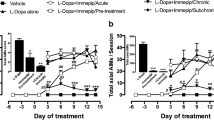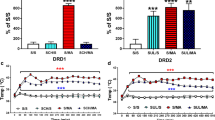Summary
Circling and asymmetric behaviours to apomorphine (dopamine agonist/antagonist) challenge were studied in rats with unilateral striatal electrolesions or 6-hydroxydopamine (6-OHDA) lesions, each induced by combined lesions at 3 striatal locations, to allow an assessment of drug action on ‘normal’ receptors in the intact striatum or ‘supersensitive’ receptors in the lesioned striatum respectively. The minimally effective dose of 6-OHDA (given in the presence of DMI and tranylcypromine) to cause functional change was 3×8 μg, with 3×32 μg providing maximal change. Electrolesions were shown histologically to be confined to striatal tissue, and dopamine depletions caused by 6-OHDA were selective for the striatum.
Temporal differences were recorded for onset of asymmetry and circling behaviour, both between behaviours and between lesions. Thus, asymmetry developed during the 2nd–4th days after 6-OHDA lesion but circling developed more abruptly on postoperative days 10–12. In contrast, both asymmetry and circling behaviours were apparent from the first day following electrolesion. The dose-dependent effects of apomorphine were apparent at much lower doses in 6-OHDA lesioned than electrolesioned rats. This potency difference was also demonstrated for two further dopamine agonists, 2-di-n-propylamino-5,6-dihydroxytetralin and SK & F 38393. In contrast, the agonist-induced asymmetric and circling behaviours of electrolesioned rats were some 9–44 times more sensitive than those of 6-OHDA lesioned rats to antagonism by the neuroleptic agents haloperidol, α-flupenthixol and oxiperomide, although tiapride antagonism was very similar in both the electrolesioned and 6-OHDA-lesioned rats. Thus, selective striatal denervation techniques are used to show that asymmetric and circling behaviours can be differentially induced and manipulated, and that the increased sensitivity (over electrolesions) of 6-OHDA lesioned rats to dopamine agonist action to induce these behavioural effects is associated with a reduced sensitivity to neuroleptic activity to reduce the asymmetric and circling responses.
Similar content being viewed by others
References
Arnt J (1982) Differential effects of neuroleptics on 3-PPP and amphetamine-induced circling behaviour in 6-hydroxydopamine lesioned rats. Br J Pharmacol 77:308P
Costall B, Naylor RJ, Pycock CJ (1976) Non-specific supersensitivity of striatal dopamine receptors after 6-hydroxydopamine lesion of the nigrostriatal pathway. Eur J Pharmacol 35:275–283
Costall B, Fortune DH, Naylor RJ, Nohria V (1979) A study of drug action on normal and denervated striatal mechanisms. Eur J Pharmacol 56:207–216
De Groot J (1959) The rat brain in stereotaxic coordinates. Verh K Ned Akad Wet 52:14–40
Hyttel J (1980) Further evidence that 3H. Cis(z)flupenthixol binds to the adenylate cyclase-associated dopamine receptors (D-1) in rat corpus striatum. Psychopharmacology 67:107–109
Jenner P, Marsden CD (1981) Substituted benzamide drugs as selective neuroleptic agents. Neuropharmacology 20:1285–1293
Kelly PH, Moore KE (1976) Mesolimbic dopaminergic neurones in the rotational model of nigrostriatal function. Nature 263: 695–696
Kelly PH, Moore KE (1977) Mesolimbic dopamine neurons: effects of 6-hydroxydopamine-induced destruction and receptor blockade on drug-induced rotation of rats. Psychopharmacology 55:35–41
Laverty R, Sharman DF (1965) The estimation of small quantities of 3,4-dihydroxyphenylethylamine in tissues. Br J Pharmacol 24:538–548
Maickel RP, Cox RH, Saillant J, Miller FP (1968) A method for the determination of serotonin and norepinephrine in discrete areas of rat brain. Int J Neuropharmacol 7:275–281
Pycock CJ (1980) Turning behaviour in animals. Neuroscience 5:461–514
Pycock CJ, Marsden CD (1978) The rotating rodent. A two component system? Eur J Pharmacol 47:167–175
Setler PE, Malesky M, McDevitt J, Turner K (1978) Rotation produced by administration of dopamine and related substances directly into the supersensitive caudate nucleus. Life Sci 23:1277–1284
Ungerstedt U, Butcher LL, Butcher SG, Andén NE, Fuxe K (1969) Direct chemical stimulation of dopaminergic mechanisms in the neostriatum of the rat. Brain Res 14:461–471
Author information
Authors and Affiliations
Rights and permissions
About this article
Cite this article
Costall, B., Elizabeth Kelly, M. & Naylor, R.J. Unilateral striatal dopamine denervation: Reduced motor inhibitory effects of dopamine antagonists revealed in models of asymmetric and circling behaviour. Naunyn-Schmiedeberg's Arch. Pharmacol. 326, 29–35 (1984). https://doi.org/10.1007/BF00518775
Received:
Accepted:
Issue Date:
DOI: https://doi.org/10.1007/BF00518775




